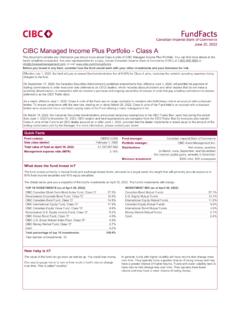Transcription of Annual Report
1 Annual Report November 30, 2021. ALPS Clean Energy ETF (NYSE ARCA: ACES). ALPS Disruptive Technologies ETF (NYSE ARCA: DTEC). ALPS Global Travel Beneficiaries ETF (NYSE ARCA: JRNY). ALPS Medical Breakthroughs ETF (NYSE ARCA: SBIO). An ALPS Advisors Solution Table of Contents Performance Overview ALPS Clean Energy ETF .. 1. ALPS Disruptive Technologies ETF .. 4. ALPS Global Travel Beneficiaries ETF .. 7. ALPS Medical Breakthroughs ETF .. 10. Disclosure of Fund Expenses .. 13. Report of Independent Registered Public Accounting Firm .. 14. Financial Statements Schedule of Investments ALPS Clean Energy ETF .. 15. ALPS Disruptive Technologies ETF .. 17. ALPS Global Travel Beneficiaries ETF .. 19. ALPS Medical Breakthroughs ETF .. 21. Statements of Assets and Liabilities .. 23. Statements of Operations .. 24. Statements of Changes in Net Assets ALPS Clean Energy ETF .. 25. ALPS Disruptive Technologies ETF .. 26. ALPS Global Travel Beneficiaries ETF .. 27. ALPS Medical Breakthroughs ETF.
2 28. Financial Highlights .. 29. Notes to Financial Statements .. 33. Additional Information .. 42. Board Considerations Regarding Approval of Investment Advisory Agreements .. 46. Trustees & Officers .. 48. ALPS Clean Energy ETF. Performance Overview November 30, 2021 (Unaudited). Investment Objective The ALPS Clean Energy ETF (the Fund or ACES ) seeks investment results that correspond (before fees and expenses) generally to the performance of its underlying index, the CIBC Atlas Clean Energy Total Return Index (ticker symbol NACEX) (the Underlying Index ). The Underlying Index utilizes a rules based methodology developed by CIBC National Trust Company, which is designed to provide exposure to a diverse set of and Canadian companies involved in the clean energy sector including renewables and clean technology. The Fund employs a passive management or indexing investment approach designed to track the performance of the Underlying Index. The Underlying Index utilizes a rules based methodology developed by CIBC National Trust Company (the Index Provider ), which is designed to provide exposure to a diverse set of and Canadian companies involved in the clean energy sector including renewables and clean technology.
3 The clean energy sector is comprised of companies that provide the products and services that enable the evolution of a more sustainable energy sector. Clean energy business segments include, but are not limited to, the following activities: (i) renewable energy sources, including solar power, wind power, hydroelectricity, geothermal energy, biomass, biofuels, and tidal/wave energy, (ii) clean technologies, including electric vehicles, energy storage, lithium, fuel cell, smart grid, and energy efficiency technologies and (iii) other emerging clean energy activities and technologies. The Underlying Index is compiled by the Index Provider and may be comprised of or Canadian companies. In order to be eligible for inclusion in the Underlying Index, a company's stock must be traded on one or more major or Canadian securities exchanges, be based in the or in Canada, have a minimum float adjusted market capitalization and minimum average daily trading value thresholds established by the index rulebook of at least $300 million, and have a minimum median average daily trading liquidity of greater than $3 million over the last 60 trading days prior to the selection date, and the company must derive a majority of its value from clean energy business segments (as defined above).
4 Such eligible companies shall be defined as the Index Universe. All equity securities meeting the above criteria are selected for inclusion in the Index Universe. The Underlying Index is reconstituted and rebalanced quarterly on the third Friday in March, June, September and December. Performance Overview The ALPS Clean Energy ETF for the twelve month period ended November 30, 2021, generated a total return of Performance was in line with the Fund's Underlying Index, net of fees, which returned The Fund underperformed the S&P 1000 Total Return Index, which returned for the same period. The S&P 500 Total Return Index returned for the trailing twelve month (TTM) period ended November 30, 2021, finishing near its all time high. Unmoved by persistent talks of inflation and policy changes, markets surged without significant drawdowns until September. October proved resilient, as the drawdown was met by a swift bounce back to all time highs for most of the averages.
5 Main macroeconomic talking points throughout 2021 centered on inflation and the question of how transitory price increases would turn out to be. Inflation fears continued to be justified with the Consumer Price Index (CPI) surging in October, along with core inflation readings increasing for the same month; both indicators notching their largest increases since December 1990, and August 1991, respectively. Federal Reserve Chairman Powell was quick to reassure markets of the non persistent inflation narrative throughout 2021 and announced a taper and reduction of balance sheet purchases starting in November of 21. Although the Fed plans to complete tapering before any rate hikes in 2022, projections of the magnitude for said rate increases vary, as global supply chain woes and the newly discovered COVID 19 Omicron variant do not ensure a future without added policy support. Despite a murky economic landscape for 2021 and heading into the New Year, global GDP surpassed pre pandemic levels in 2021, aided by policy support and strong consumer spending.
6 Record profit margins for corporations led the way for record valuations through most of the year, but were matched by an earnings season in Q3 where many companies cut forward looking expectations amid a slowing global growth outlook. 2021 saw an acceleration of clean energy adoption and mandates driven by legislation. The Biden Administration has set forth initiatives to decarbonize the electric sector by 2035, setting the precedent for further infrastructure spending and tax credits aimed at achieving the lofty goals. The $1 trillion Bipartisan Infrastructure Bill was signed into law in November, with specific mandates targeting the funds towards initiatives that will reduce emissions by 50 52% from 2005 levels in 2030, and to create a 100% carbon pollution free power sector by 2035. Electric vehicles stole the spotlight throughout the year with Tesla outperforming competitors and IPOs from the likes of Rivian and Lucid Motors. It is likely that North America will see more policy support targeted at clean energy infrastructure in the near future, as projections call for immediate increases in policy action in order to meet a net zero global fleet by 2050.
7 The best performing stocks in the Fund for the period were Ameresco Inc., Class A (AMRC), which increased , Enviva Partners LP (EVA), which saw a gain of , and Tesla, Inc. (TSLA), which rose The largest detractors were Workhorse Group, Inc. (WKHS), which decreased , XEBEC Adsorption, Inc. (XBC CN), which fell , and TPI Composites, Inc. (TPIC), which lost ACES Underlying Index has a differentiated approach to investing in the clean energy sector. First, by narrowing the list of constituents to companies whose primary operations are focused on clean energy, the Fund offers more pure play exposure to the clean energy sector. Second, constituents are diversified across the sector and offer exposure to the full opportunity set of the transition from fossil fuels to renewable energy. Lastly, focusing on and Canadian based companies helps to further minimize the risk of investing in a global industry by reducing risks related to foreign holdings, including currency exchange rates, financial disclosures, and regulatory and policy changes.
8 1 | November 30, 2021. ALPS Clean Energy ETF. Performance Overview November 30, 2021 (Unaudited). Fund Performance (as of November 30, 2021). 1 Year 3 Year Since Inception^. ALPS Clean Energy ETF NAV ALPS Clean Energy ETF Market Price* S&P 1000 Total Return Index CIBC Atlas Clean Energy Total Return Index Total Expense Ratio (per the current prospectus) is Performance data quoted represents past performance. Past performance does not guarantee future results. Total return figures assume reinvestment of dividends and capital gains distributions, if any. The table does not reflect the deduction of taxes that a shareholder would pay on Fund distributions or the redemption of Fund shares. Investment return and principal value of an investment will fluctuate so that an investor 's shares, when sold or redeemed, may be worth more or less than the original cost. Current performance data may be higher or lower than actual data quoted. For the most current month-end performance data please visit or call NAV is an exchange-traded fund's per-share value.
9 The per-share dollar amount of the fund is derived by dividing the total value of all the securities in its portfolio, less any liabilities, by the number of fund shares outstanding. Market Price is the price at which a share can currently be traded in the market. Information detailing the number of days the Market Price of the Fund was greater than the Fund's NAV and the number of days it was less than the Fund's NAV can be obtained at ^ The Fund commenced operations on June 28, 2018, with the first day of trading on the exchange of June 29, 2018. * Market Price means the official closing price of a share or, if it more accurately reflects the market value of a share at the time as of which the Fund calculates current net asset value per share, the price that is the midpoint of the bid-ask spread as of that time. It does not represent the returns an investor would receive if shares were traded at other times. CIBC Atlas Clean Energy Total Return Index is an adjusted market cap weighted index designed to provide exposure to a diverse set of or Canadian based companies involved in the clean energy sector including renewables and clean technology.
10 The clean energy sector is comprised of companies that provide the products and services which enable the evolution of a more sustainable energy sector. Clean energy business segments include but are not limited to: solar, wind, hydro, geothermal, electric vehicles, LED, biomass, smart grid, energy efficiency and storage. Total return assumes reinvestment of any dividends and distributions realized during a given time period. The S&P 1000 Total Return Index combines the S&P MidCap 400 and the S&P SmallCap 600 to form an investable benchmark for the mid- to small-cap segment of the equity market. Total return assumes reinvestment of any dividends and distributions realized during a given time period. One cannot invest directly in an index. Index performance does not reflect fund performance. The Fund's shares are not individually redeemable. Investors buy and sell shares of the Fund on a secondary market. Only market makers or authorized participants may trade directly with the Fund, typically in blocks of 25,000 shares.







